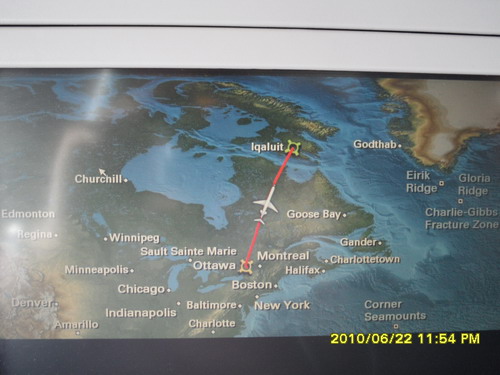
1 On June 22, 2010, I flied to Iqaluit from Ottawa by Air Canada 8963, took me 3 hours, the flight distance is 1,298 miles or 2,088 kms. Ottawa and Iqaluit currently have equivalent time zones. The Arctic landscape from the air was desolate, hilly and barren.
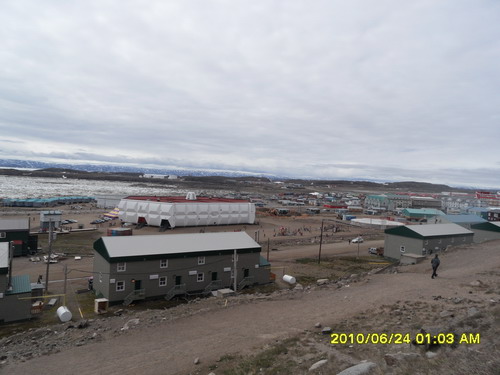
2. A panorama picture of Iqaluit( pronounced “ee-ha-loo-eet”, means "place of many fish")- formerly Frobisher Bay-is the capital of Nunavut, Canada’s newest territory. It is locates in Baffin Island, at 33.5 metres above sea level. Coordinates:63° 44′ 55″ N, 68° 31′ 11″ W.
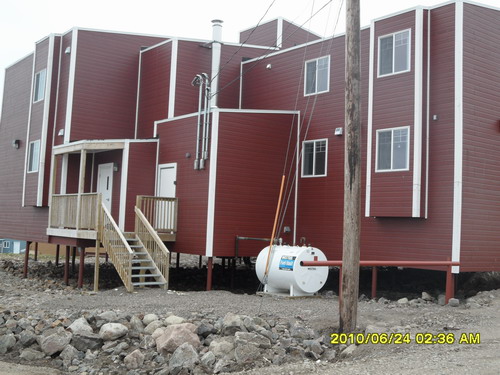
3 Residential housing in Iqaluit, this was my Hotel in June 2011, the Accommodation by The Sea, I stayed at the building for 6 days, Ca$175/room/day with breakfast. The building looks like cabins that are raised off the ground because of the harsh Canadian Arctic winters. Iqaluit has no street addresses, only house numbers, houses were numbered in the order they were built.
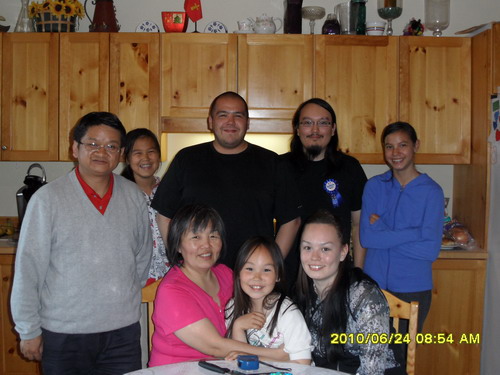
4. Took part in an Inuit family birthday party.
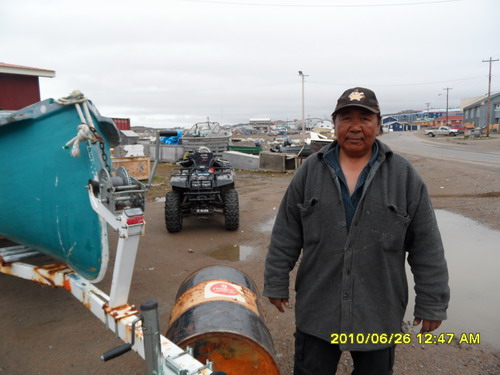
5. An Inuit fisherman is preparing boat for fishing, July-Oct. As the residents of Canadian north Arctic Region, Inuit people play a very important role in the economic and social development. Traditionally, the Inuit have been nomadic and remained closely tied to the land in their hunting and fishing practices. Now, all the Inuit have been settled in the 46 northern communities of the Inuit nunaat (lands of the Inuit).
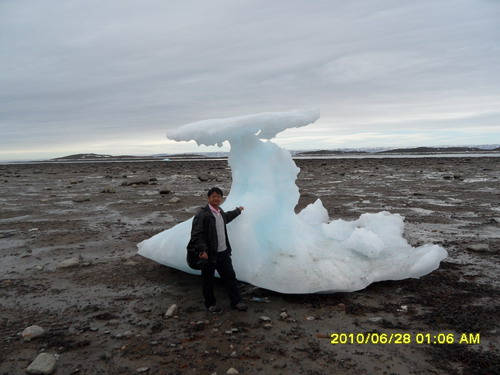
6. Witnessing an iceberg in the summer, on 28th June 2010 in the Frobisher Bay. It experiences some of the highest tides in North America. The surrounding landscape combines beachfront and rolling, rocky tundra, dotted with lakes and rivers.
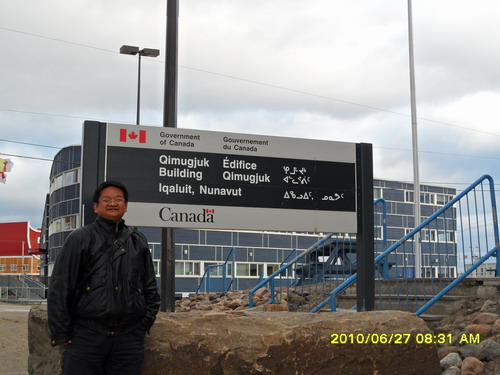
7 Iqaluit Qimugjuk Building, Government of Canada. Iqaluit Street signs written in Inuktitut syllabics. The official Languages are Inuktitut, English and French in Nunavut. Iqaluit’s economy based mainly on a government that has expanded rapidly since the city became the capital of Nunavut in 1999.

8. Hudson’s Bay Company in Apex. Just five kilometres from Iqaluit, home to the historic St. Simon’s Church and the original Hudson’s Bay Co. buildings. In the early years of the 20th century, free traders visited the Inuit in Baffin Island, seeking sealskins and furs. On their heels, settlement-Roman Catholic and Anglican missionaries establish beachheads.
On June 2010, funded by the Canadian Embassy in Beijing, “The Special Award for Canadian Studies Program” ,I had an opportunity to the far north Canadian arctic Iqaluit. It took me three hours from Ottawa to Iqaluit, the flight distance is 1,298 miles or 2,088 kms. Ottawa and Iqaluit currently have equivalent time zones. The only way to Iqaluit is by air, there are no roads into Nunavut. However, Iqaluit has daily scheduled flights connecting with Ottawa, Montreal, Yellowknife and other community in Nunavut. Fares are steep: Full fare is $2,430 return to fly between Iqaluit and Ottawa, schedules can change, especially according to the season and the weather.
I qaluit is the capital of Nunavut, Canada’s newest territory set up in 1999. It is at 63º45’ N, 68º31’ W on the shores of Koojesse Inlet in Baffin Island, at 33.5 metres above sea level. Iqaluit is the largest community in Nunavut, it received it’s Order of Official Status as a City in 2001. It has a population of about 7000. The mean temperature in January is -30°C and in July is 15°C.
Everything is very expensive in Iqaluit almost 2 times price than south of Canada. Here’s a food price(not including tax) in a downtown grocery stores: Lean ground beef, per kg $10.29; One dozen eggs $3.09; Two litres 2% milk $5.99; One loaf white bread $2.59; White flour, 2.2 kg bag $8.49; Butter, 454 g $3.99; One head iceberg lettuce $3.99; Granny Smith apples, per kg $5.78. Living cost is really expensive, a small, one-bedroom apartment would cost you about $1400 per month.
There’s lots of time to enjoy its attractions in the summer as Iqaluit receives about 24 hours of daylight during the peak of the summer season. The masterful architecture of Nunavut’s legislative assembly can be found in the heart of downtown Iqaluit. The three-storey building incorporates traditional Inuit motifs, such as the shapes of kayaks and sleds. A visit to the Nunatta sunakkutaangit Museum is a fun experience. The permanent collection of Inuit artifacts and historical photographs will both inform and entertain. Many Inuit rely on their handicrafts to sustain their livelihood.
AN IQALUIT CHRONOLOGY
700 BC People of the Dorset culture (or Tuniit, as they are called by the Inuit today) replace earlier (“pre-Dorset”) settlers in the Eastern Arctic.
1000 AD Thule-culture whalers, ancestors of modern Inuit, migrate into the region; the Dorset disappear.
1576 Martin Frobisher arrives in search of a Northwest Passage. Convinced he’s found gold on what’s now called Qadlunaat Island, he ships tonnes of ore back to England, leaving traces of Elizabethan industry that can still be seen today. (The glittery stuff turns out to be mica.)
1861 Charles Francis Hall, an American, camps at the mouth of the Sylvia Grinnell River and explores the waters of Koojesse Inlet, which he names for his Inuit guide.
1800s American and European whalers arrive in the waters of south Baffin Island, taking countless bowhead. The Inuit work and trade with them.
1880 Sovereignty over the Arctic Islands is passed to Canada by Britain.
1900s Whaling comes to a halt in the early years of the 20th century. Free traders continue to visit the Inuit, seeking sealskins and furs. On their heels, Roman Catholic and Anglican missionaries establish beachheads.
1914 The Hudson’s Bay Company sets up shop about 65 km from present-day Iqaluit, at Ward Inlet.
1920s The Bay continues to establish Baffin posts, and the RCMP moves north to reinforce Canada’s sovereignty in the Eastern and High Arctic.
1930s The worldwide collapse of fur prices creates economic difficulties for the Inuit of the Frobisher Bay area.
1942 The United States Air Force comes to Koojesse Inlet to build a wartime base for planes headed to Europe.
1943 With the base in full operation, improved transportation and communications prompt the Bay to move its post from Ward Inlet to Niaqunngut, or Apex, where Inuit have also moved.
1955-57 The settlement now called Frobisher Bay becomes a centre for DEW Line construction, bringing in equipment, materials and hundreds of workers.
In 1957,the population is 1200.
1959 The Government of Canada brings doctors, nurses, teachers and bureaucrats to Frobisher Bay. More Inuit settle permanently at Niaqunngut (Apex) and Frobisher Bay.
1960 - 63 Frobisher Bay is host to a U.S. Strategic Air Command unit. By the time the USAF departs, Frobisher Bay is established as Canada’s administrative hub in the Eastern Arctic.
1964 Frobisher Bay’s first Community Council is formed.
1970 Frobisher Bay is officially recognized as a settlement.
1974 The settlement becomes a village.
1976 The Inuit Tapirisat of Canada proposes the creation of a new territory in the Eastern Arctic, to be called Nunavut.
1979 Frobisher Bay is officially declared a town.
1987 The town reverts to its original Inuktitut name, Iqaluit (“place of fishes”).
1993 In May, the Nunavut Land Claims Agreement is signed in Iqaluit.
1995 The people of the Eastern Arctic select Iqaluit to become capital of Nunavut.
1999 Iqaluit celebrates April 1, the day Nunavut officially comes into being.
2001 Iqaluit gains official status as a city April 19.
2002 Iqaluit, along with Nuuk Greenland, co-host the first jointly hosted Arctic Winter Games.
5 February 2010 - Iqaluit hosted the finance meeting as part of the 2010 G7 summit
(Source: The Relocation Guide to Iqaluit, http://www.city.iqaluit.nu.ca)